light MAZDA MODEL 3 HATCHBACK 2012 (in English) User Guide
[x] Cancel search | Manufacturer: MAZDA, Model Year: 2012, Model line: MODEL 3 HATCHBACK, Model: MAZDA MODEL 3 HATCHBACK 2012Pages: 525, PDF Size: 5.95 MB
Page 39 of 525
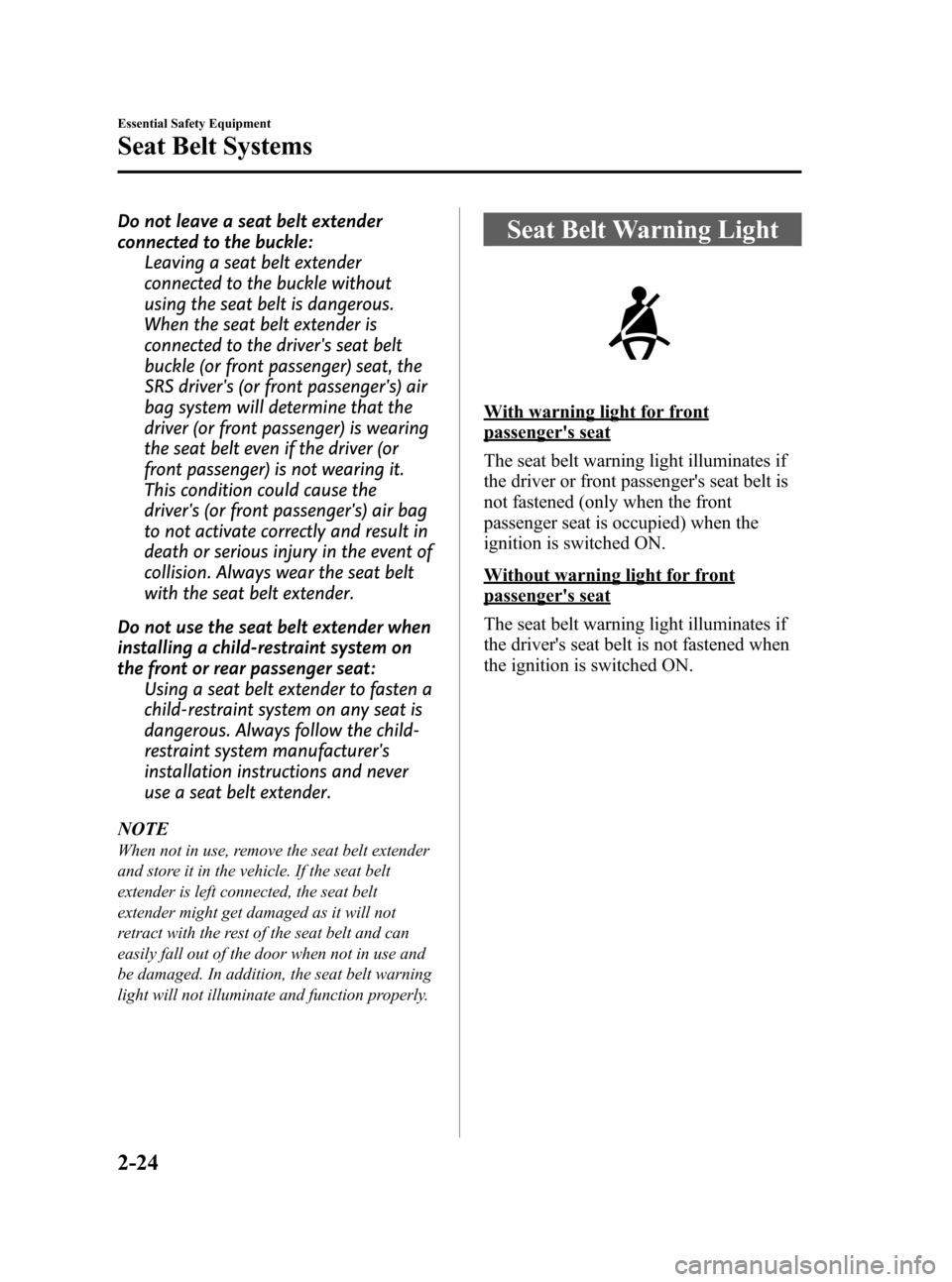
Black plate (38,1)
Do not leave a seat belt extender
connected to the buckle:Leaving a seat belt extender
connected to the buckle without
using the seat belt is dangerous.
When the seat belt extender is
connected to the driver's seat belt
buckle (or front passenger) seat, the
SRS driver's (or front passenger's) air
bag system will determine that the
driver (or front passenger) is wearing
the seat belt even if the driver (or
front passenger) is not wearing it.
This condition could cause the
driver's (or front passenger's) air bag
to not activate correctly and result in
death or serious injury in the event of
collision. Always wear the seat belt
with the seat belt extender.
Do not use the seat belt extender when
installing a child-restraint system on
the front or rear passenger seat: Using a seat belt extender to fasten a
child-restraint system on any seat is
dangerous. Always follow the child-
restraint system manufacturer's
installation instructions and never
use a seat belt extender.
NOTE
When not in use, remove the seat belt extender
and store it in the vehicle. If the seat belt
extender is left connected, the seat belt
extender might get damaged as it will not
retract with the rest of the seat belt and can
easily fall out of the door when not in use and
be damaged. In addition, the seat belt warning
light will not illuminate and function properly.
Seat Belt Warning Light
With warning light for front
passenger's seat
The seat belt warning light illuminates if
the driver or front passenger's seat belt is
not fastened (only when the front
passenger seat is occupied) when the
ignition is switched ON.
Without warning light for front
passenger's seat
The seat belt warning light illuminates if
the driver's seat belt is not fastened when
the ignition is switched ON.
2-24
Essential Safety Equipment
Seat Belt Systems
Mazda3_8BY7-EC-11F_Edition1 Page38
Friday, June 17 2011 2:54 PM
Form No.8BY7-EC-11F
Page 40 of 525
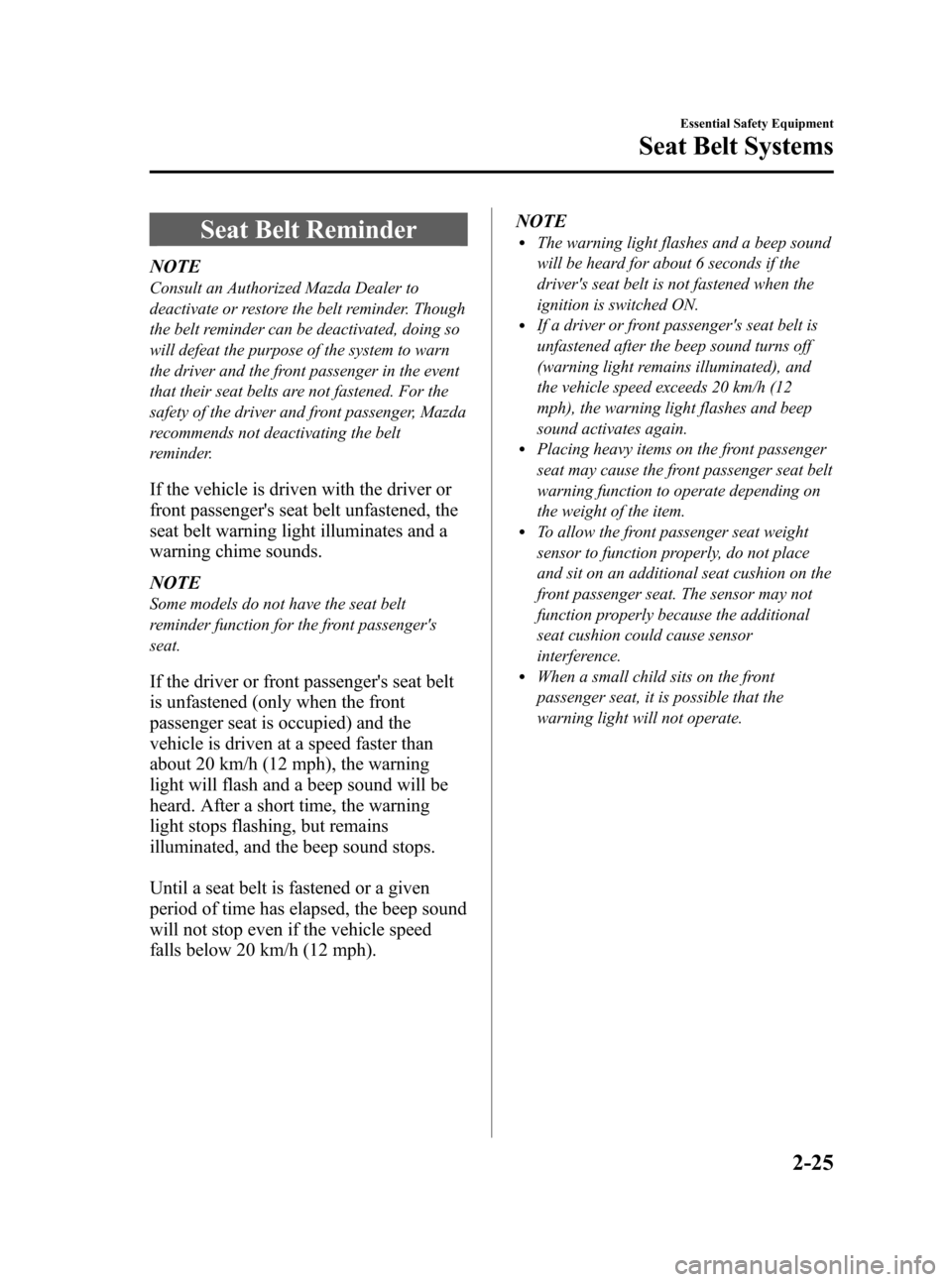
Black plate (39,1)
Seat Belt Reminder
NOTE
Consult an Authorized Mazda Dealer to
deactivate or restore the belt reminder. Though
the belt reminder can be deactivated, doing so
will defeat the purpose of the system to warn
the driver and the front passenger in the event
that their seat belts are not fastened. For the
safety of the driver and front passenger, Mazda
recommends not deactivating the belt
reminder.
If the vehicle is driven with the driver or
front passenger's seat belt unfastened, the
seat belt warning light illuminates and a
warning chime sounds.
NOTE
Some models do not have the seat belt
reminder function for the front passenger's
seat.
If the driver or front passenger's seat belt
is unfastened (only when the front
passenger seat is occupied) and the
vehicle is driven at a speed faster than
about 20 km/h (12 mph), the warning
light will flash and a beep sound will be
heard. After a short time, the warning
light stops flashing, but remains
illuminated, and the beep sound stops.
Until a seat belt is fastened or a given
period of time has elapsed, the beep sound
will not stop even if the vehicle speed
falls below 20 km/h (12 mph).NOTE
lThe warning light flashes and a beep sound
will be heard for about 6 seconds if the
driver's seat belt is not fastened when the
ignition is switched ON.
lIf a driver or front passenger's seat belt is
unfastened after the beep sound turns off
(warning light remains illuminated), and
the vehicle speed exceeds 20 km/h (12
mph), the warning light flashes and beep
sound activates again.
lPlacing heavy items on the front passenger
seat may cause the front passenger seat belt
warning function to operate depending on
the weight of the item.
lTo allow the front passenger seat weight
sensor to function properly, do not place
and sit on an additional seat cushion on the
front passenger seat. The sensor may not
function properly because the additional
seat cushion could cause sensor
interference.
lWhen a small child sits on the front
passenger seat, it is possible that the
warning light will not operate.
Essential Safety Equipment
Seat Belt Systems
2-25
Mazda3_8BY7-EC-11F_Edition1 Page39
Friday, June 17 2011 2:54 PM
Form No.8BY7-EC-11F
Page 41 of 525
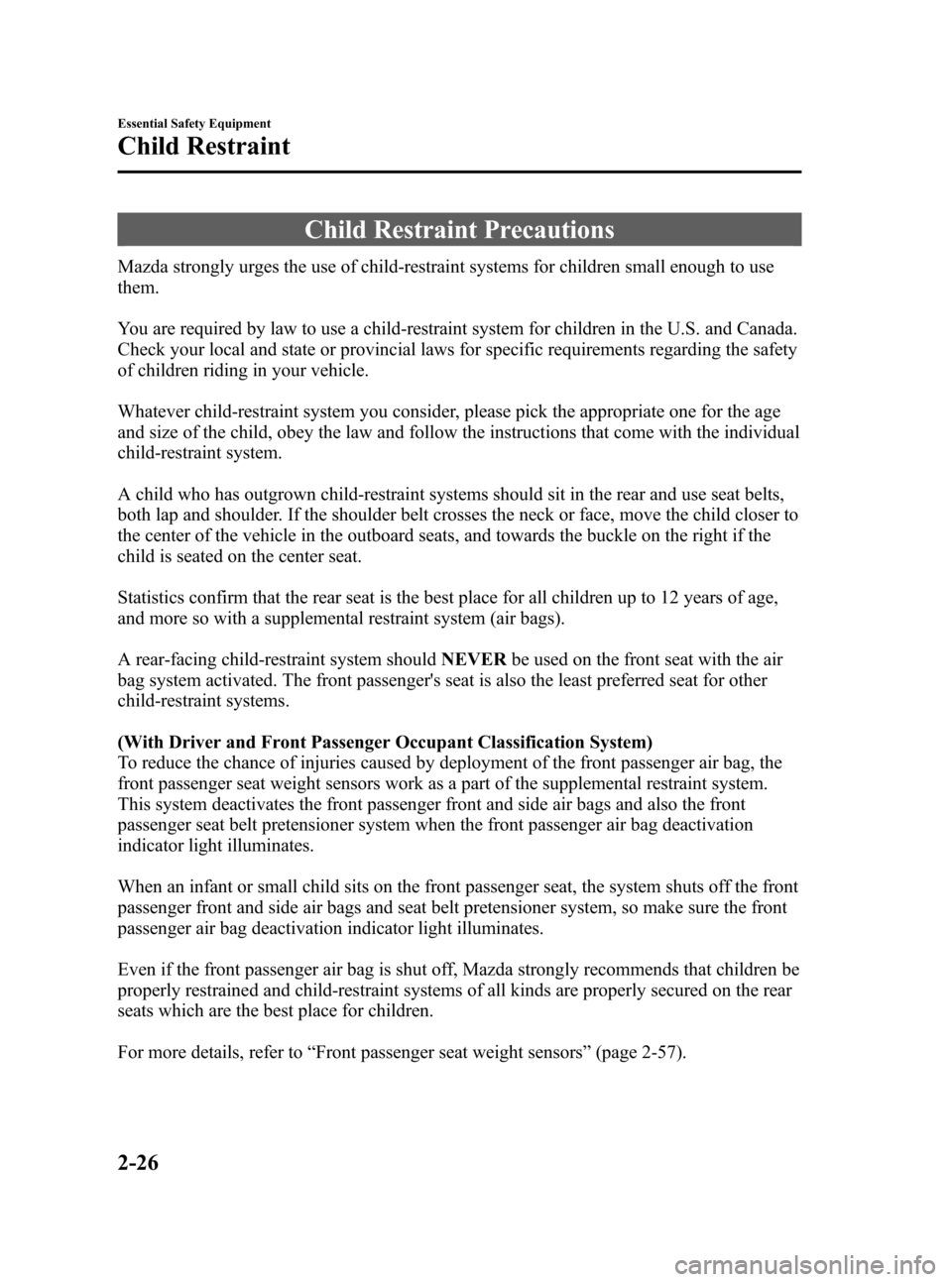
Black plate (40,1)
Child Restraint Precautions
Mazda strongly urges the use of child-restraint systems for children small enough to use
them.
You are required by law to use a child-restraint system for children in the U.S. and Canada.
Check your local and state or provincial laws for specific requirements regarding the safety
of children riding in your vehicle.
Whatever child-restraint system you consider, please pick the appropriate one for the age
and size of the child, obey the law and follow the instructions that come with the individual
child-restraint system.
A child who has outgrown child-restraint systems should sit in the rear and use seat belts,
both lap and shoulder. If the shoulder belt crosses the neck or face, move the child closer to
the center of the vehicle in the outboard seats, and towards the buckle on the right if the
child is seated on the center seat.
Statistics confirm that the rear seat is the best place for all children up to 12 years of age,
and more so with a supplemental restraint system (air bags).
A rear-facing child-restraint system shouldNEVERbe used on the front seat with the air
bag system activated. The front passenger's seat is also the least preferred seat for other
child-restraint systems.
(With Driver and Front Passenger Occupant Classification System)
To reduce the chance of injuries caused by deployment of the front passenger air bag, the
front passenger seat weight sensors work as a part of the supplemental restraint system.
This system deactivates the front passenger front and side air bags and also the front
passenger seat belt pretensioner system when the front passenger air bag deactivation
indicator light illuminates.
When an infant or small child sits on the front passenger seat, the system shuts off the front
passenger front and side air bags and seat belt pretensioner system, so make sure the front
passenger air bag deactivation indicator light illuminates.
Even if the front passenger air bag is shut off, Mazda strongly recommends that children be
properly restrained and child-restraint systems of all kinds are properly secured on the rear
seats which are the best place for children.
For more details, refer to “Front passenger seat weight sensors ”(page 2-57).
2-26
Essential Safety Equipment
Child Restraint
Mazda3_8BY7-EC-11F_Edition1 Page40
Friday, June 17 2011 2:54 PM
Form No.8BY7-EC-11F
Page 42 of 525
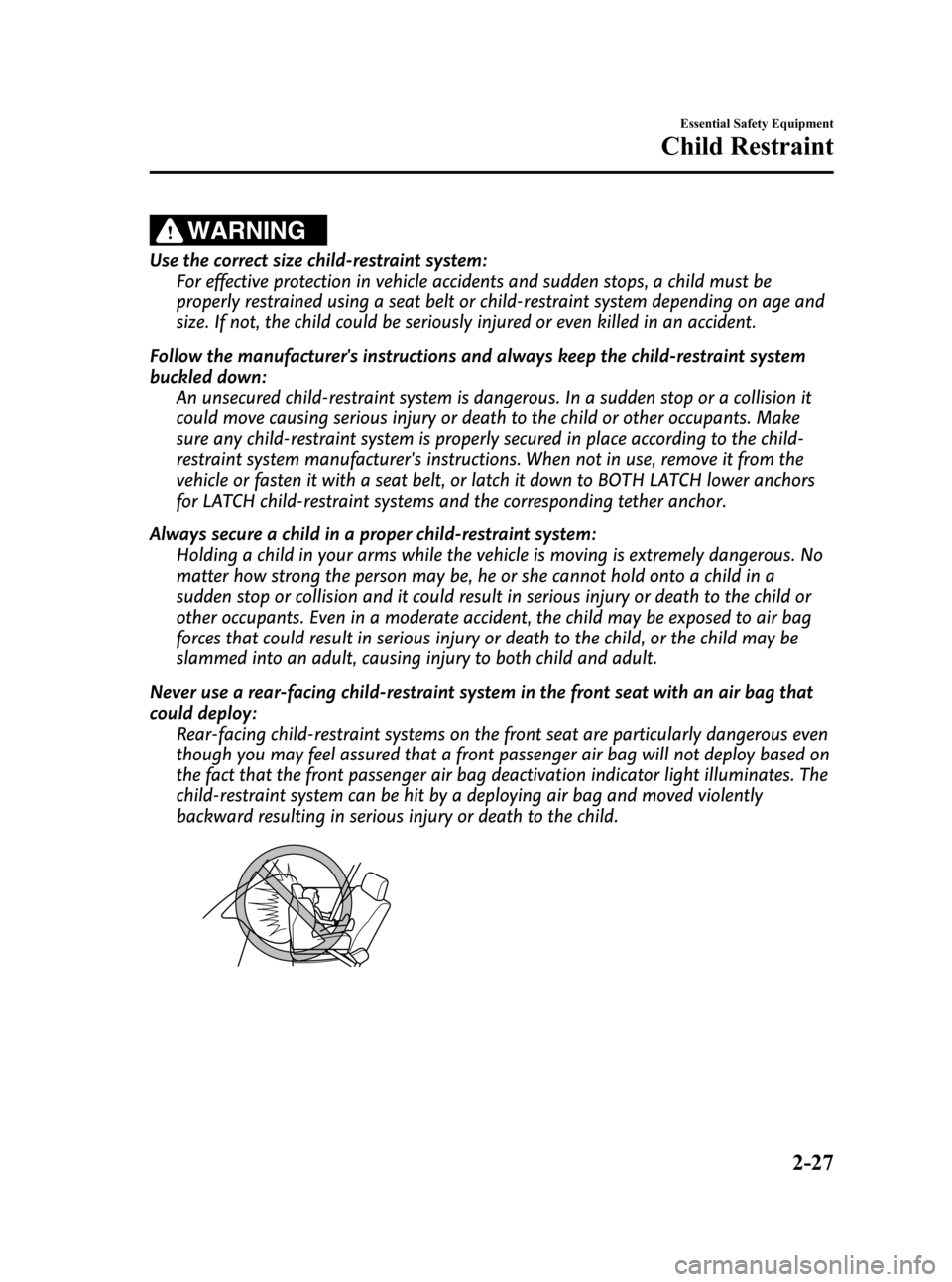
Black plate (41,1)
WARNING
Use the correct size child-restraint system:For effective protection in vehicle accidents and sudden stops, a child must be
properly restrained using a seat belt or child-restraint system depending on age and
size. If not, the child could be seriously injured or even killed in an accident.
Follow the manufacturer's instructions and always keep the child-restraint system
buckled down: An unsecured child-restraint system is dangerous. In a sudden stop or a collision it
could move causing serious injury or death to the child or other occupants. Make
sure any child-restraint system is properly secured in place according to the child-
restraint system manufacturer's instructions. When not in use, remove it from the
vehicle or fasten it with a seat belt, or latch it down to BOTH LATCH lower anchors
for LATCH child-restraint systems and the corresponding tether anchor.
Always secure a child in a proper child-restraint system: Holding a child in your arms while the vehicle is moving is extremely dangerous. No
matter how strong the person may be, he or she cannot hold onto a child in a
sudden stop or collision and it could result in serious injury or death to the child or
other occupants. Even in a moderate accident, the child may be exposed to air bag
forces that could result in serious injury or death to the child, or the child may be
slammed into an adult, causing injury to both child and adult.
Never use a rear-facing child-restraint system in the front seat with an air bag that
could deploy: Rear-facing child-restraint systems on the front seat are particularly dangerous even
though you may feel assured that a front passenger air bag will not deploy based on
the fact that the front passenger air bag deactivation indicator light illuminates. The
child-restraint system can be hit by a deploying air bag and moved violently
backward resulting in serious injury or death to the child.
Essential Safety Equipment
Child Restraint
2-27
Mazda3_8BY7-EC-11F_Edition1 Page41
Friday, June 17 2011 2:54 PM
Form No.8BY7-EC-11F
Page 44 of 525
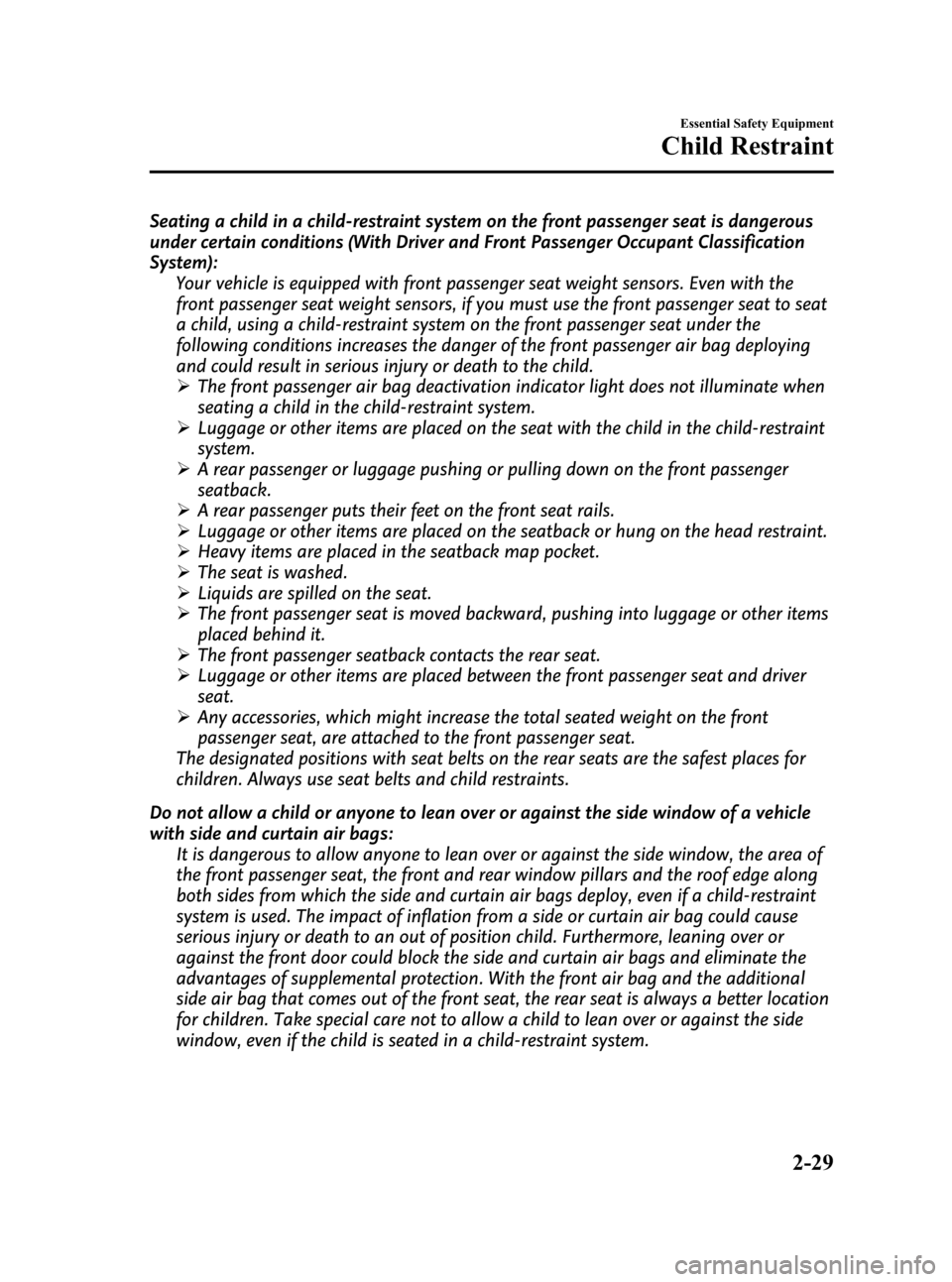
Black plate (43,1)
Seating a child in a child-restraint system on the front passenger seat is dangerous
under certain conditions (With Driver and Front Passenger Occupant Classification
System):Your vehicle is equipped with front passenger seat weight sensors. Even with the
front passenger seat weight sensors, if you must use the front passenger seat to seat
a child, using a child-restraint system on the front passenger seat under the
following conditions increases the danger of the front passenger air bag deploying
and could result in serious injury or death to the child.
ØThe front passenger air bag deactivation indicator light does not illuminate when
seating a child in the child-restraint system.
Ø Luggage or other items are placed on the seat with the child in the child-restraint
system.
Ø A rear passenger or luggage pushing or pulling down on the front passenger
seatback.
Ø A rear passenger puts their feet on the front seat rails.
Ø Luggage or other items are placed on the seatback or hung on the head restraint.
Ø Heavy items are placed in the seatback map pocket.
Ø The seat is washed.
Ø Liquids are spilled on the seat.
Ø The front passenger seat is moved backward, pushing into luggage or other items
placed behind it.
Ø The front passenger seatback contacts the rear seat.
Ø Luggage or other items are placed between the front passenger seat and driver
seat.
Ø Any accessories, which might increase the total seated weight on the front
passenger seat, are attached to the front passenger seat.
The designated positions with seat belts on the rear seats are the safest places for
children. Always use seat belts and child restraints.
Do not allow a child or anyone to lean over or against the side window of a vehicle
with side and curtain air bags: It is dangerous to allow anyone to lean over or against the side window, the area of
the front passenger seat, the front and rear window pillars and the roof edge along
both sides from which the side and curtain air bags deploy, even if a child-restraint
system is used. The impact of inflation from a side or curtain air bag could cause
serious injury or death to an out of position child. Furthermore, leaning over or
against the front door could block the side and curtain air bags and eliminate the
advantages of supplemental protection. With the front air bag and the additional
side air bag that comes out of the front seat, the rear seat is always a better location
for children. Take special care not to allow a child to lean over or against the side
window, even if the child is seated in a child-restraint system.
Essential Safety Equipment
Child Restraint
2-29
Mazda3_8BY7-EC-11F_Edition1 Page43
Friday, June 17 2011 2:54 PM
Form No.8BY7-EC-11F
Page 51 of 525
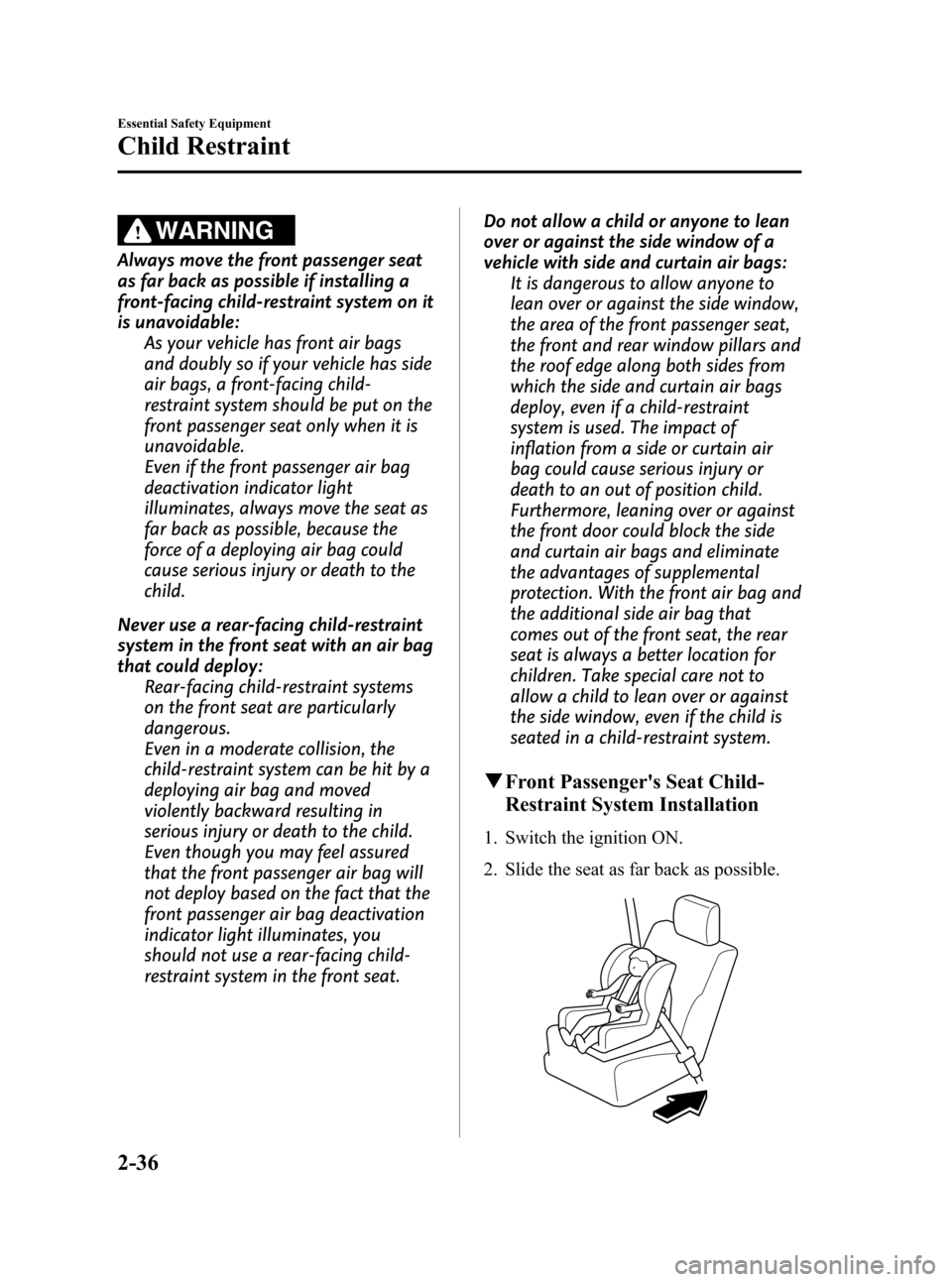
Black plate (50,1)
WARNING
Always move the front passenger seat
as far back as possible if installing a
front-facing child-restraint system on it
is unavoidable:As your vehicle has front air bags
and doubly so if your vehicle has side
air bags, a front-facing child-
restraint system should be put on the
front passenger seat only when it is
unavoidable.
Even if the front passenger air bag
deactivation indicator light
illuminates, always move the seat as
far back as possible, because the
force of a deploying air bag could
cause serious injury or death to the
child.
Never use a rear-facing child-restraint
system in the front seat with an air bag
that could deploy: Rear-facing child-restraint systems
on the front seat are particularly
dangerous.
Even in a moderate collision, the
child-restraint system can be hit by a
deploying air bag and moved
violently backward resulting in
serious injury or death to the child.
Even though you may feel assured
that the front passenger air bag will
not deploy based on the fact that the
front passenger air bag deactivation
indicator light illuminates, you
should not use a rear-facing child-
restraint system in the front seat. Do not allow a child or anyone to lean
over or against the side window of a
vehicle with side and curtain air bags:
It is dangerous to allow anyone to
lean over or against the side window,
the area of the front passenger seat,
the front and rear window pillars and
the roof edge along both sides from
which the side and curtain air bags
deploy, even if a child-restraint
system is used. The impact of
inflation from a side or curtain air
bag could cause serious injury or
death to an out of position child.
Furthermore, leaning over or against
the front door could block the side
and curtain air bags and eliminate
the advantages of supplemental
protection. With the front air bag and
the additional side air bag that
comes out of the front seat, the rear
seat is always a better location for
children. Take special care not to
allow a child to lean over or against
the side window, even if the child is
seated in a child-restraint system.
qFront Passenger's Seat Child-
Restraint System Installation
1. Switch the ignition ON.
2. Slide the seat as far back as possible.
2-36
Essential Safety Equipment
Child Restraint
Mazda3_8BY7-EC-11F_Edition1 Page50
Friday, June 17 2011 2:54 PM
Form No.8BY7-EC-11F
Page 52 of 525
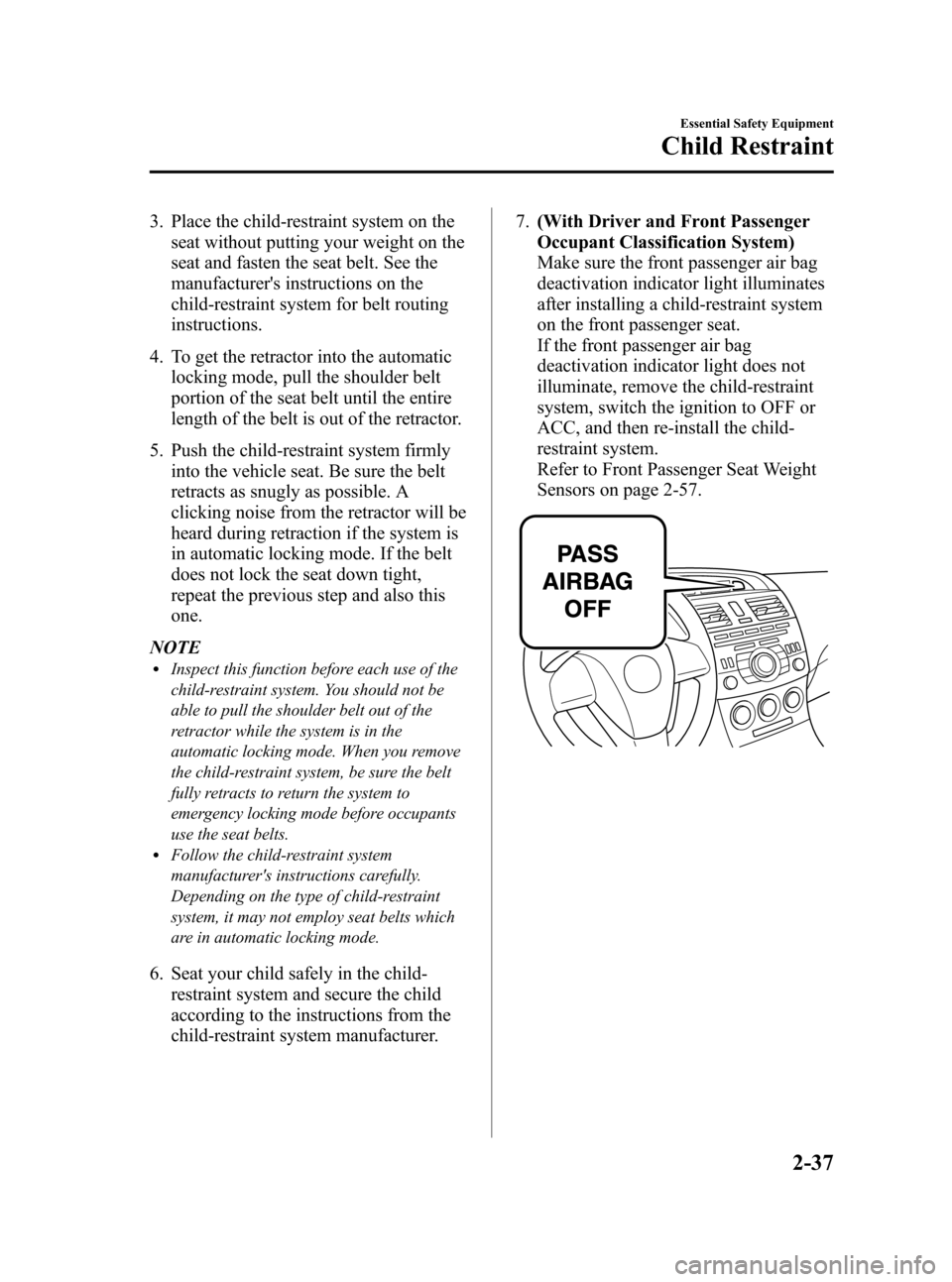
Black plate (51,1)
3. Place the child-restraint system on theseat without putting your weight on the
seat and fasten the seat belt. See the
manufacturer's instructions on the
child-restraint system for belt routing
instructions.
4. To get the retractor into the automatic locking mode, pull the shoulder belt
portion of the seat belt until the entire
length of the belt is out of the retractor.
5. Push the child-restraint system firmly into the vehicle seat. Be sure the belt
retracts as snugly as possible. A
clicking noise from the retractor will be
heard during retraction if the system is
in automatic locking mode. If the belt
does not lock the seat down tight,
repeat the previous step and also this
one.
NOTE
lInspect this function before each use of the
child-restraint system. You should not be
able to pull the shoulder belt out of the
retractor while the system is in the
automatic locking mode. When you remove
the child-restraint system, be sure the belt
fully retracts to return the system to
emergency locking mode before occupants
use the seat belts.
lFollow the child-restraint system
manufacturer's instructions carefully.
Depending on the type of child-restraint
system, it may not employ seat belts which
are in automatic locking mode.
6. Seat your child safely in the child- restraint system and secure the child
according to the instructions from the
child-restraint system manufacturer. 7.
(With Driver and Front Passenger
Occupant Classification System)
Make sure the front passenger air bag
deactivation indicator light illuminates
after installing a child-restraint system
on the front passenger seat.
If the front passenger air bag
deactivation indicator light does not
illuminate, remove the child-restraint
system, switch the ignition to OFF or
ACC, and then re-install the child-
restraint system.
Refer to Front Passenger Seat Weight
Sensors on page 2-57.
Essential Safety Equipment
Child Restraint
2-37
Mazda3_8BY7-EC-11F_Edition1 Page51
Friday, June 17 2011 2:54 PM
Form No.8BY7-EC-11F
Page 53 of 525
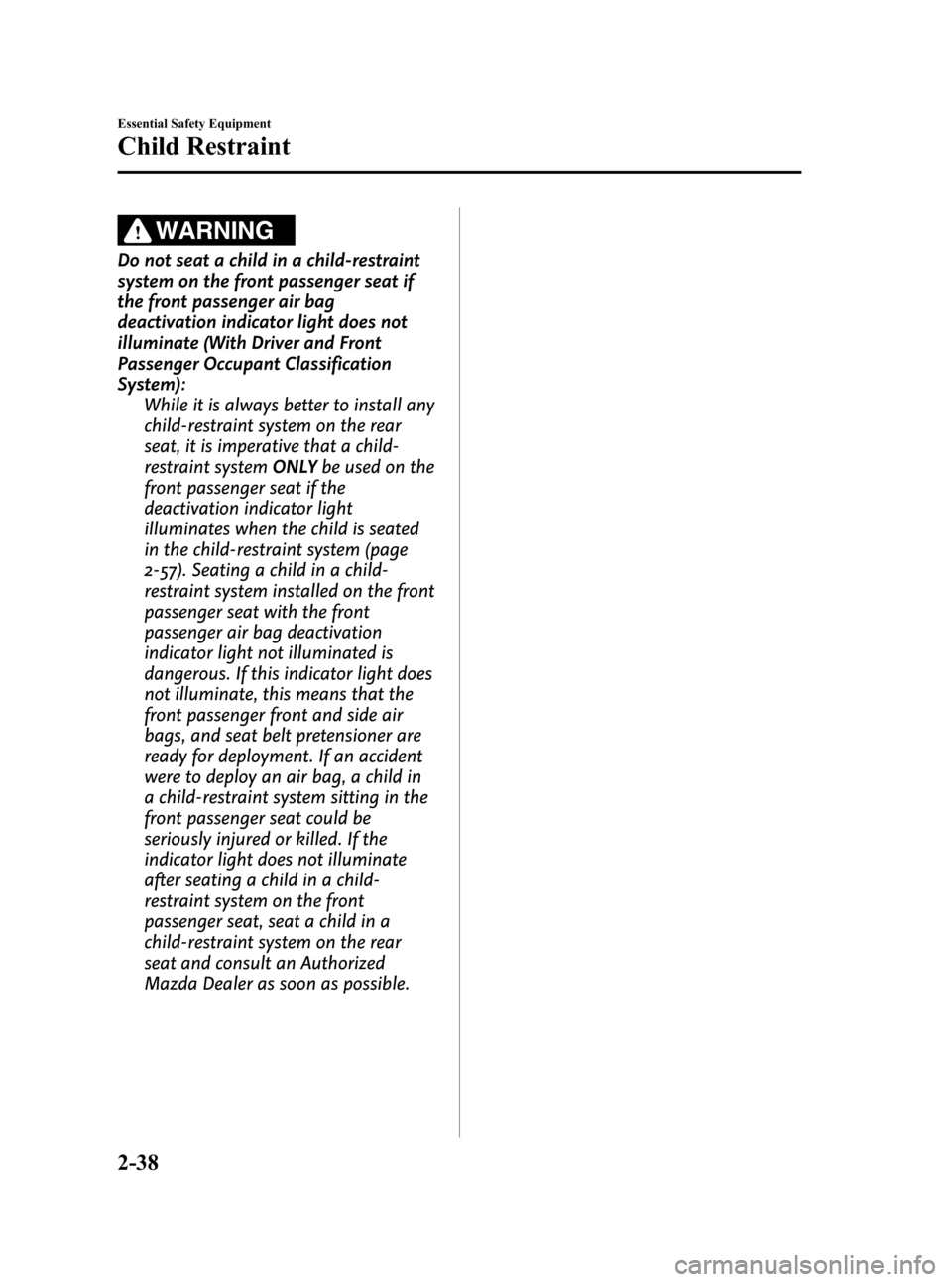
Black plate (52,1)
WARNING
Do not seat a child in a child-restraint
system on the front passenger seat if
the front passenger air bag
deactivation indicator light does not
illuminate (With Driver and Front
Passenger Occupant Classification
System):While it is always better to install any
child-restraint system on the rear
seat, it is imperative that a child-
restraint system ONLYbe used on the
front passenger seat if the
deactivation indicator light
illuminates when the child is seated
in the child-restraint system (page
2-57). Seating a child in a child-
restraint system installed on the front
passenger seat with the front
passenger air bag deactivation
indicator light not illuminated is
dangerous. If this indicator light does
not illuminate, this means that the
front passenger front and side air
bags, and seat belt pretensioner are
ready for deployment. If an accident
were to deploy an air bag, a child in
a child-restraint system sitting in the
front passenger seat could be
seriously injured or killed. If the
indicator light does not illuminate
after seating a child in a child-
restraint system on the front
passenger seat, seat a child in a
child-restraint system on the rear
seat and consult an Authorized
Mazda Dealer as soon as possible.
2-38
Essential Safety Equipment
Child Restraint
Mazda3_8BY7-EC-11F_Edition1 Page52
Friday, June 17 2011 2:54 PM
Form No.8BY7-EC-11F
Page 55 of 525
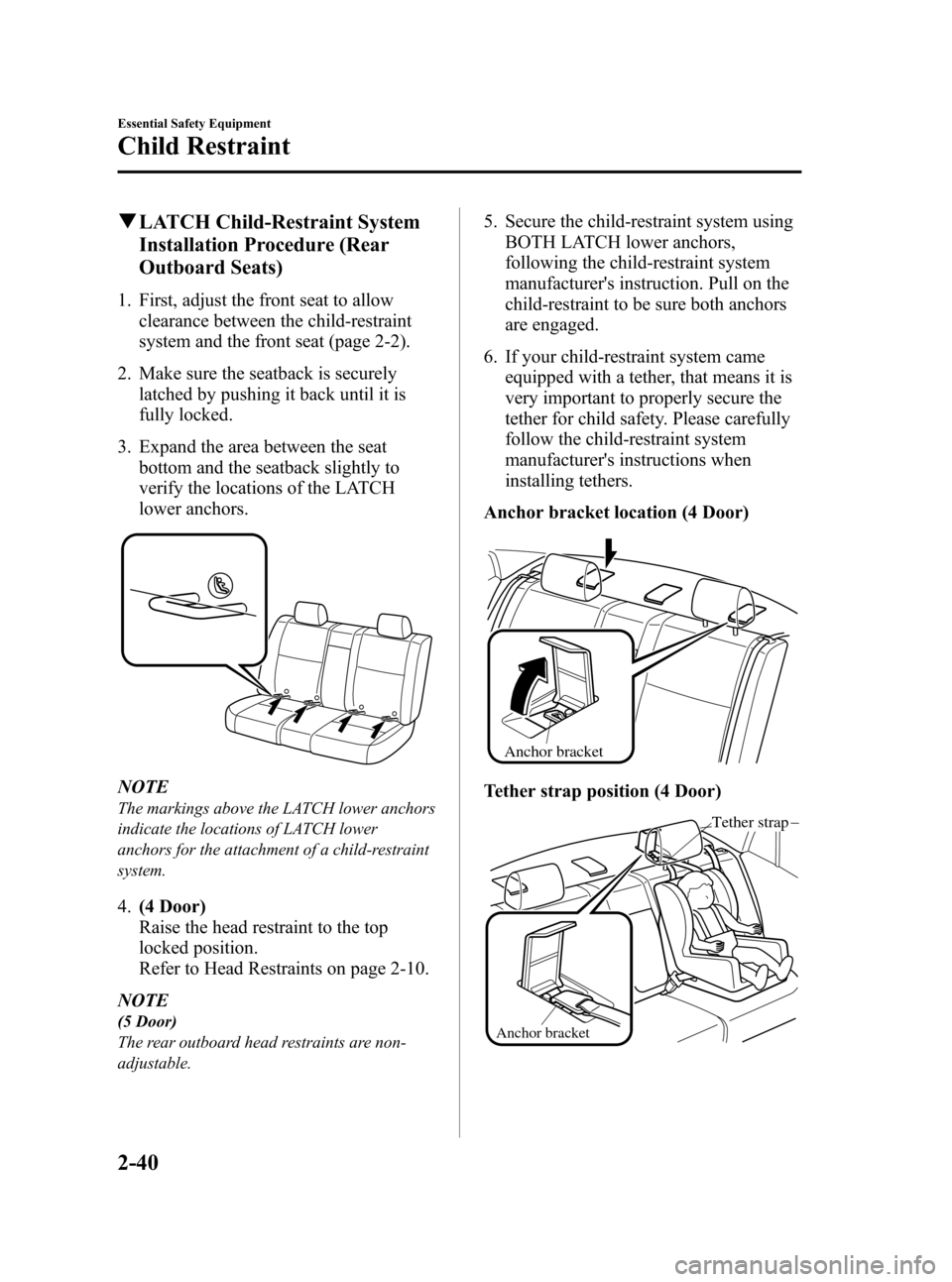
Black plate (54,1)
qLATCH Child-Restraint System
Installation Procedure (Rear
Outboard Seats)
1. First, adjust the front seat to allow
clearance between the child-restraint
system and the front seat (page 2-2).
2. Make sure the seatback is securely latched by pushing it back until it is
fully locked.
3. Expand the area between the seat bottom and the seatback slightly to
verify the locations of the LATCH
lower anchors.
NOTE
The markings above the LATCH lower anchors
indicate the locations of LATCH lower
anchors for the attachment of a child-restraint
system.
4.(4 Door)
Raise the head restraint to the top
locked position.
Refer to Head Restraints on page 2-10.
NOTE
(5 Door)
The rear outboard head restraints are non-
adjustable.
5. Secure the child-restraint system using BOTH LATCH lower anchors,
following the child-restraint system
manufacturer's instruction. Pull on the
child-restraint to be sure both anchors
are engaged.
6. If your child-restraint system came equipped with a tether, that means it is
very important to properly secure the
tether for child safety. Please carefully
follow the child-restraint system
manufacturer's instructions when
installing tethers.
Anchor bracket location (4 Door)
Anchor bracket
Tether strap position (4 Door)
Anchor bracket
Tether strap
2-40
Essential Safety Equipment
Child Restraint
Mazda3_8BY7-EC-11F_Edition1 Page54
Friday, June 17 2011 2:54 PM
Form No.8BY7-EC-11F
Page 57 of 525
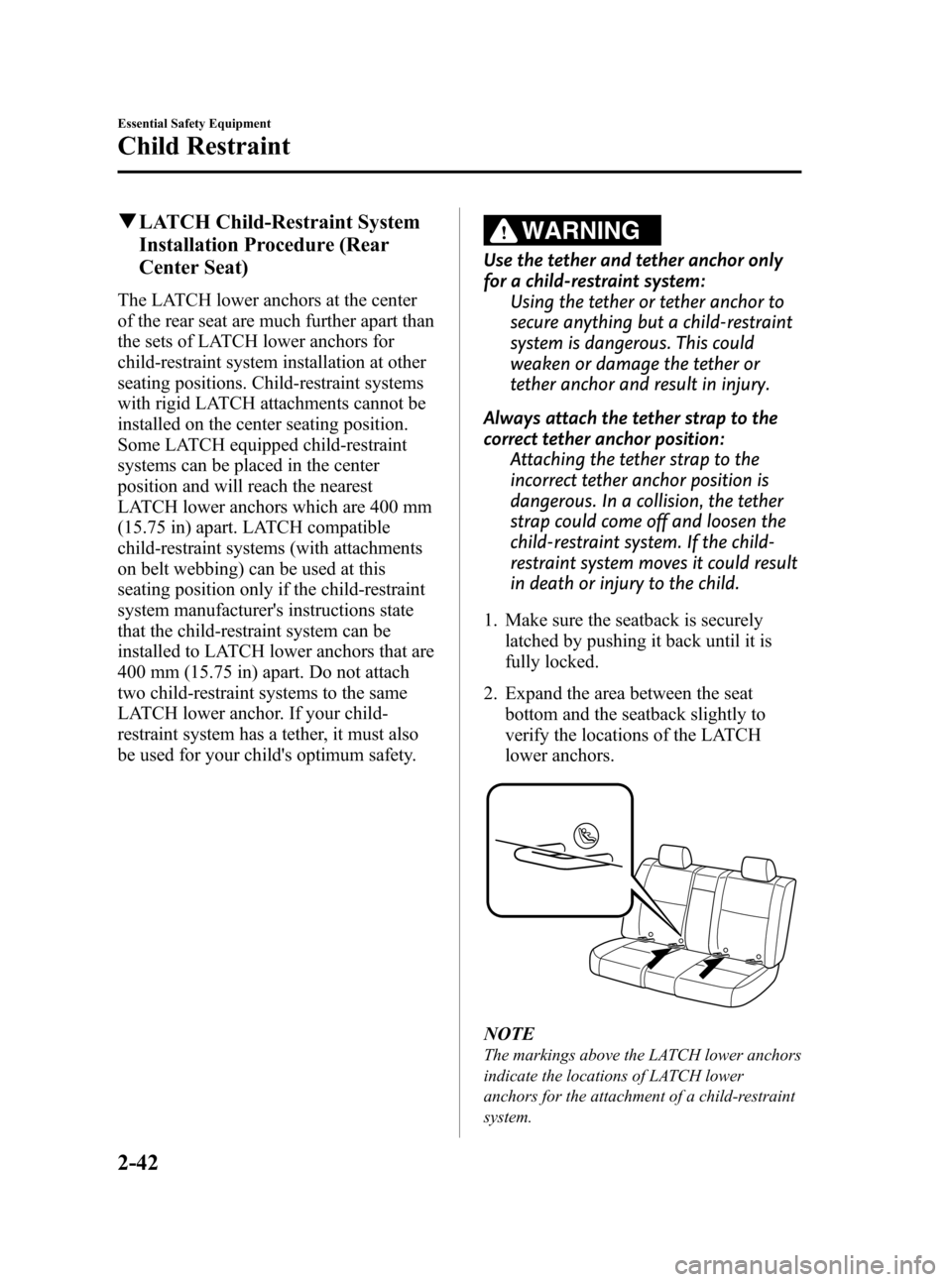
Black plate (56,1)
qLATCH Child-Restraint System
Installation Procedure (Rear
Center Seat)
The LATCH lower anchors at the center
of the rear seat are much further apart than
the sets of LATCH lower anchors for
child-restraint system installation at other
seating positions. Child-restraint systems
with rigid LATCH attachments cannot be
installed on the center seating position.
Some LATCH equipped child-restraint
systems can be placed in the center
position and will reach the nearest
LATCH lower anchors which are 400 mm
(15.75 in) apart. LATCH compatible
child-restraint systems (with attachments
on belt webbing) can be used at this
seating position only if the child-restraint
system manufacturer's instructions state
that the child-restraint system can be
installed to LATCH lower anchors that are
400 mm (15.75 in) apart. Do not attach
two child-restraint systems to the same
LATCH lower anchor. If your child-
restraint system has a tether, it must also
be used for your child's optimum safety.
WARNING
Use the tether and tether anchor only
for a child-restraint system:
Using the tether or tether anchor to
secure anything but a child-restraint
system is dangerous. This could
weaken or damage the tether or
tether anchor and result in injury.
Always attach the tether strap to the
correct tether anchor position: Attaching the tether strap to the
incorrect tether anchor position is
dangerous. In a collision, the tether
strap could come off and loosen the
child-restraint system. If the child-
restraint system moves it could result
in death or injury to the child.
1. Make sure the seatback is securely latched by pushing it back until it is
fully locked.
2. Expand the area between the seat bottom and the seatback slightly to
verify the locations of the LATCH
lower anchors.
NOTE
The markings above the LATCH lower anchors
indicate the locations of LATCH lower
anchors for the attachment of a child-restraint
system.
2-42
Essential Safety Equipment
Child Restraint
Mazda3_8BY7-EC-11F_Edition1 Page56
Friday, June 17 2011 2:54 PM
Form No.8BY7-EC-11F